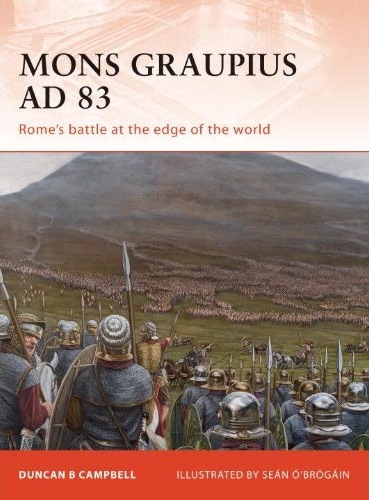
Duncan B. Campbell
Mons Graupius AD 83: Rome’s Battle at the Edge of the World
Campaign 224 (Oxford: Osprey, 2010). 96 pp. $19.95. ISBN 9781846039263.
Duncan B. Campbell’s Mons Graupius AD 83: Rome’s Battle at the Edge of the World is a welcome addition to the exciting “Campaign” series published by Osprey. It joins such noteworthy books as William Shepherd’s Salamis 480 BC: The Naval Campaign that Saved Greece, Si Sheppard’s Actium 31 BC: Downfall of Antony and Cleopatra, Nic Fields’ Thermopylae 480 BC: Last Stand of the 300, and Michael Thompson’s Granicus 334 BC: Alexander’s First Persian Victory. Seán Ó’Brógáin’s illustrations complement well Campbell’s account of this battle which, Tacitus writes, took place at the end of the world and nature: in ipso terrarum ac naturae fine (Agricola, 33). Although this battle was located in a vastly remote part of the empire, it was the most important military achievement of Agricola, the Roman governor in Britain, and a battle that allowed Agricola to hand over to his successor a country that was safe and at peace (tradiderat interim Agricola successori suo provinciam quietam tutamque, ibid., 40).
Campbell’s text covers the origins of the campaign, reviews what is known about Agricola and his men and Calgacus and the Caledonians, and supplies the reader with a chronological narrative of the Roman governor’s first through sixth seasons (AD 77–82). The author, who is a specialist in ancient Greek and Roman warfare, concisely, yet with a good grasp for detail, takes the reader through the battle and its aftermath and introduces some theories regarding the possible site of this ancient battle.
However, the text does have some problems, such as items that are lacking from the text that would have improved the work. For example, it would have been helpful to have included an index locorum along with the general index. In addition, a more complete bibliography is highly desirable. The bibliography for this slender volume may be adequate for the nature of Osprey’s “Campaign” series that has as its stated aim to give “accounts of history’s greatest conflicts, detailing the command strategies, tactics and battle experiences of the opening forces throughout the crucial stages of each campaign” (this quotation is taken from promotional material from the publisher). However, the bibliography does not seem adequate for some of the statements made by the author. For example, Campbell relies on the unpublished findings of Stan Wolfson when discussing the poetic parallels between the work of Silius Italicus and Tacitus’ Agricola and includes Wolfson’s unpublished textual emendation of the Boresti passage from Agricola 38: Wolfson emends the accepted in finis borestorum exercitum deducit to in finis boreos totum exercitum deducit. Campbell also selects Wolfson’s emendation on the Trucculensian harbor passage (Agricola, 38) for praise (trucculensem portum tenuit should read trux Thulensem portum tenuit). The uneasiness this creates is not that the emendations from this notoriously problematic text are not convincing; rather, the unpublished work of Wolfson does not allow for a careful appraisal of Wolfson’s argument.
Another bibliographical difficulty arises when Campbell partially refers to a scholarly source and does not include it fully in the bibliography. For example, in his argument against those who dispute the veracity of Tacitus’ account of the battle or even that the battle took place, Campbell refers to Martin Henig’s work, yet no full citation is given; the only information supplied is the journal, volume year, and publication date. Since the referenced work is not extensive or detailed in length, Campbell could easily have included the entire reference. Campbell could then have quoted from Henig’s work so that the reader could consider the argument in a greater context. Campbell does note that Henig, “subsequently recanted his denial of Mons Grapius, conceding that there was ‘skirmish in the hills’” (87), a denial that is contained in a brief letter to the British Archaeology journal.
This is a minor quibble with a text that can be considered a competent and detailed introduction to the battle at Mons Graupius. The bibliographical problems discussed above are insignificant in comparison to the value of the work. I recommend this work to all who are interested in the battle at Mons Grapius, the Roman conquest of Britain, or the life of Agricola.
 Edmund P. Cueva
Edmund P. Cueva